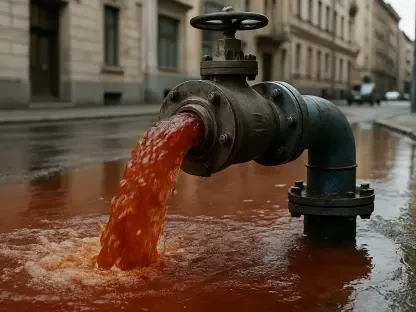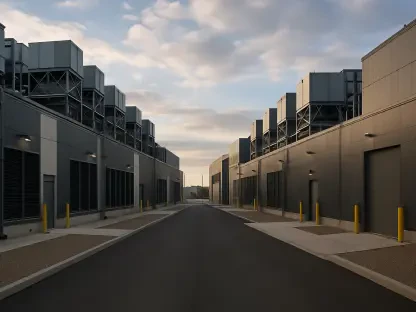Residents of Clayville are facing a severe water contamination issue, which has persisted for over a decade. The contamination, caused by a crack in the foundation of a state-owned salt barn, has led to high sodium chloride levels in their well water. This situation has resulted in serious health and financial implications for the affected community, prompting them to consider legal action against the Rhode Island Department of Transportation (RIDOT).
The Origin of the Problem
A Decade-Old Crack and Its Impact
The contamination problem began ten years ago when a crack in the foundation of the RIDOT salt barn allowed sodium chloride to leach into the groundwater. The extensive leak has affected the wells of approximately 25 Clayville residents, causing high chloride levels in their drinking water. This issue has not been confined to just Clayville, as residents over the border in Foster have also found high levels of sodium chloride in their water supplies.
The high sodium chloride levels in the well water are not just a minor inconvenience; they pose serious health risks to the residents. Sodium chloride, commonly known as salt, is not harmful in small quantities. However, when present in high concentrations in drinking water, it can lead to a range of health issues, most notably high blood pressure. This has been a major concern for Clayville residents, many of whom have reported significant health problems since the contamination began. The crack in the salt barn’s foundation has turned into an enduring problem that RIDOT has struggled to resolve effectively.
Community Health Concerns
High blood pressure and other health issues have been widely reported among residents due to the contaminated water. Many have had to switch to bottled or treated water to alleviate their symptoms, underscoring the severity of the contamination’s impact on their well-being. For the elderly and those with pre-existing health conditions, the implications are even more dire, making access to clean water a critical need.
The high sodium chloride levels in the water have forced many residents to install costly water treatment systems to ensure their water is safe to drink. Despite these measures, the health impacts continue to be a pressing concern. Amanda Destafeno, a local resident, shared her struggle with health issues linked to the contaminated water, highlighting the community’s broader experience. Her symptoms, including severe high blood pressure, were alleviated only after switching to treated water. This case mirrors the health plight faced by numerous other residents, illustrating the significant toll the contamination has taken on the community’s overall health.
Lingering Financial Burdens
Costly Water Treatment Solutions
Residents are facing substantial financial burdens in maintaining reverse osmosis water treatment systems. These systems require significant electricity, replacement filters, water softeners, and annual maintenance, adding up to expenses that can exceed $800 per month. The financial strain is considerable, particularly for families and elderly individuals on fixed incomes, who are finding it increasingly difficult to manage these monthly costs.
The reverse osmosis systems, although effective at removing contaminants, come with their own set of challenges. The high energy consumption necessary to operate these systems contributes heavily to the residents’ electricity bills. Additionally, the need for frequent replacement of filters and water softeners further adds to the costs. The logistics and financial obligations of maintaining these systems add up over time, causing a cumulative economic burden. For Denise Foster and her neighbors, the ongoing costs of ensuring clean drinking water have become a heavy financial load, exacerbating an already stressful situation.
Property Devaluation Woes
The contamination has also led to a significant devaluation of property values in Clayville. Real estate experts estimate that homes in the affected area have depreciated by up to 30% due to the poor water quality, causing further financial distress for homeowners. This depreciation is not just a temporary setback; it represents long-term financial losses for the residents, who find themselves unable to sell their properties at a fair market value.
The property devaluation extends beyond monetary concerns. The physical footprint of the reverse osmosis systems occupies substantial basement space, leading to additional inconveniences for homeowners. The real estate market views properties with known water contamination issues unfavorably, making it difficult for residents to relocate or sell their homes. Hence, the contamination not only impacts their current living conditions but also restricts their future options, trapping them in a cycle of financial and environmental distress.
Legal and Legislative Actions
Unsatisfactory RIDOT Measures
While RIDOT provided some water treatment systems following a 2012 consent order, the affected residents feel these efforts were inconsistent and inadequate. The department’s actions have not fully addressed the root cause nor effectively mitigated the contamination. Residents suspect that the measures taken were merely superficial attempts to placate the community rather than genuine solutions to eradicate the source of the problem.
The inadequacy of RIDOT’s measures is evident in the persistent high chloride levels still found in many wells. The department’s monitoring and intervention activities, mandated by the consent order, have been criticized for their lack of effectiveness and consistency. The community believes that a more thorough approach, including repairing the salt barn and ensuring proper scrutiny of groundwater quality, is essential. The perceived neglect by RIDOT has fueled the residents’ frustration and their call for legal and legislative recourse.
Potential Class Action Lawsuit
Residents of Clayville have been grappling with a troublesome water contamination issue for over ten years. The root cause is a fissure in the foundation of a state-owned salt barn, leading to alarming levels of sodium chloride in their well water. The elevated salt content has not only posed severe health risks, including potential kidney damage and hypertension, but also significant financial burdens due to the necessity of buying bottled water and costly filtration systems. The situation has become so dire that the community is contemplating legal action against the Rhode Island Department of Transportation (RIDOT), which is responsible for the maintenance of the salt barn. The ongoing contamination issue has disrupted daily life in Clayville, forcing residents to navigate the challenges of unreliable water sources and mounting expenses. The state-owned salt barn’s defective foundation remains the focal point of the community’s grievances as they seek a resolution to restore clean, safe water to their households.









